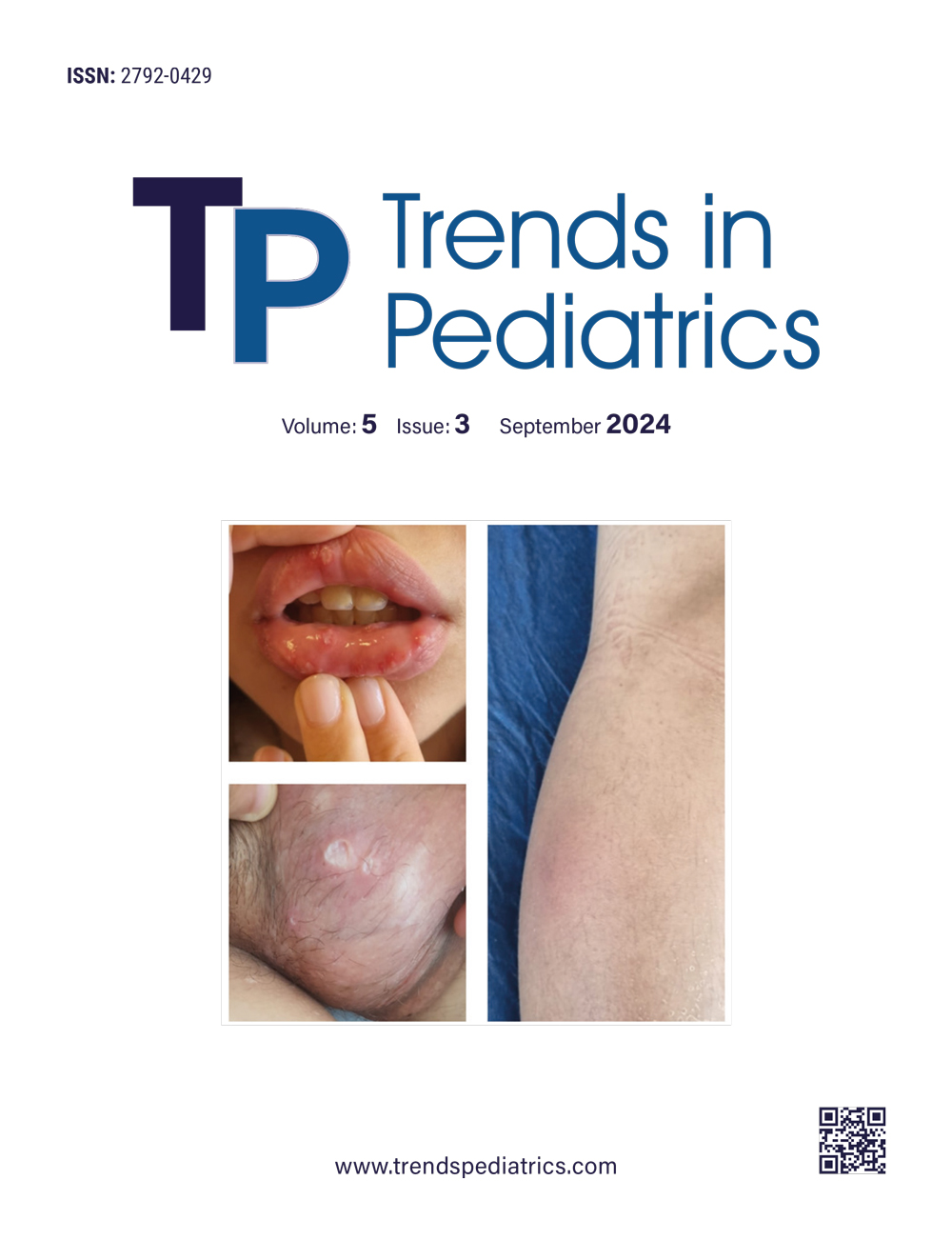Abstract
Objective: While there is a close relationship between celiac disease (CD) and intussusception, it is not yet clear whether the detection of intussusception in children requires physicians to always screen for CD. In our study, we aimed to determine the frequency of CD in children with intussusception and to find the answer to whether CD screening is necessary for every child with intussusception.
Methods: The study included 50 symptomatic pediatric patients diagnosed with intussusception who were followed up and treated in the Health Sciences University Gülhane Training and Research Hospital Pediatric Surgery Clinic between 2020–2023. CD screening was performed in patients followed up with a diagnosis of intussusception.
Results: The mean age of the patients was 3.61 ± 2.02 years, and 33 (66%) were male. Of 62 intussusceptions observed in 50 patients, 46.8% were ileo-ileal, 35.5% ileo-colic, 11.3% jejeno-jejunal, 4.8% colo-colic, and 1.6% recto-sigmoid. CD was diagnosed endoscopically in three (6%) patients with an intussusception diagnosis and an anti-tissue transglutaminase level > 200 IU/ml. Intussusceptions in 43.5% of the patients were reduced by hydrostatic reduction, 41.9% spontaneously, 9.7% laparotomically, and 4.8% laparoscopically. A single intussusception attack occurred in 82% of patients; 14% had two, 2% had three, and 2% had four. No significant correlation was found between the number of intussusception attacks and the presence of CD (p = 0.34). There was also no relationship between the type of intussusception and age (p = 0.74), gender (p = 0.24), or treatment (p = 0.12) or between the presence of CD and gender (p = 0.26), age (p = 0.68), or type (p = 0.28) of intussusception.
Conclusions: CD is more common in symptomatic children with intussusception than in healthy children. Screening pediatric patients with idiopathic intussusception for CD may reduce the recurrence of intussusception and complications and morbidities that may occur due to a delayed CD diagnosis.
Keywords: Celiac Disease, intussusception, screen, children
References
- Lebwohl B, Sanders DS, Green PHR. Coeliac disease. Lancet. 2018;391:70-81. https://doi.org/10.1016/S0140-6736(17)31796-8
- Rubin JE, Crowe SE. Celiac Disease. Ann Intern Med. 2020;172:ITC1-16. https://doi.org/10.7326/AITC202001070
- Dalgic B, Sari S, Basturk B, et al; Turkish Celiac Study Group. Prevalence of celiac disease in healthy Turkish school children. Am J Gastroenterol. 2011;106:1512-7. https://doi.org/10.1038/ajg.2011.183
- Husby S, Koletzko S, Korponay-Szabó I, et al. European Society Paediatric Gastroenterology, Hepatology and Nutrition Guidelines for Diagnosing Coeliac Disease 2020. J Pediatr Gastroenterol Nutr. 2020;70:141-56. https://doi.org/10.1097/MPG.0000000000002497
- Balamtekin N, Uslu N, Baysoy G, et al. The presentation of celiac disease in 220 Turkish children. Turk J Pediatr. 2010;52:239-44.
- Reilly NR, Aguilar KM, Green PH. Should intussusception in children prompt screening for celiac disease? J Pediatr Gastroenterol Nutr. 2013;56:56-9. https://doi.org/10.1097/MPG.0b013e31826a1099
- Kim KY. Henoch-Schönlein Purpura Presenting as Intussusception. Korean J Gastroenterol. 2017;69:372-6. https://doi.org/10.4166/kjg.2017.69.6.372
- Burnett E, Parashar UD, Tate JE. Associations of Intussusception With Adenovirus, Rotavirus, and Other Pathogens: A Review of the Literature. Pediatr Infect Dis J. 2020;39:1127-30. https://doi.org/10.1097/INF.0000000000002860
- Knowles MC, Fishman EK, Kuhlman JE, Bayless TM. Transient intussusception in Crohn disease: CT evaluation. Radiology. 1989;170:814. https://doi.org/10.1148/radiology.170.3.2916035
- Borkar VV, Poddar U, Thakral A, et al. Intussusception in celiac disease: Is it a common feature in children? J Gastroenterol Hepatol. 2018;33:380-4. https://doi.org/10.1111/jgh.13865
- Ensari A, Marsh MN. Diagnosing celiac disease: a critical overview. Turk J Gastroenterol. 2019;30:389-97. https://doi.org/10.5152/tjg.2018.18635
- Charles T, Penninga L, Reurings JC, Berry MCJ. Intussusception in Children: A Clinical Review. Acta Chir Belg. 2015;115:327-33. https://doi.org/10.1080/00015458.2015.11681124
- Sun Z, Song G, Lian D, Zhang Q, Dong L. Process Management of Intussusception in Children: A Retrospective Analysis in China. Pediatr Emerg Care. 2022;38:321-5. https://doi.org/10.1097/PEC.0000000000002700
- Jenke AC, Klaassen-Mielke R, Zilbauer M, Heininger U, Trampisch H, Wirth S. Intussusception: incidence and treatment-insights from the nationwide German surveillance. J Pediatr Gastroenterol Nutr. 2011;52:446-51. https://doi.org/10.1097/MPG.0b013e31820e1bec
- Guo WL, Hu ZC, Tan YL, Sheng M, Wang J. Risk factors for recurrent intussusception in children: a retrospective cohort study. BMJ Open. 2017;7:e018604. https://doi.org/10.1136/bmjopen-2017-018604
- Beres AL, Baird R. An institutional analysis and systematic review with meta-analysis of pneumatic versus hydrostatic reduction for pediatric intussusception. Surgery. 2013;154:328-34. https://doi.org/10.1016/j.surg.2013.04.036
- Li Y, Zhou Q, Liu C, et al. Epidemiology, clinical characteristics, and treatment of children with acute intussusception: a case series. BMC Pediatr. 2023;23:143. https://doi.org/10.1186/s12887-023-03961-y
- Goyal P, Nohria S, Singh Grewal C, Sehgal R, Goyal O. Celiac disease and intussusception - a rare but important association. Acta Gastroenterol Belg. 2022;85:111-2. https://doi.org/10.51821/85.1.7959
- AlAhmad M, Almessabi A. Transient Small-Bowel Intussusception Unmasking Adult Celiac Disease. Case Rep Gastroenterol. 2022;16:44-8. https://doi.org/10.1159/000521542
- Gonda TA, Khan SU, Cheng J, Lewis SK, Rubin M, Green PH. Association of intussusception and celiac disease in adults. Dig Dis Sci. 2010;55:2899-903. https://doi.org/10.1007/s10620-009-1086-8
- Paul C, Anderson S. The Correlation Between Pediatric Intussusceptions and Celiac Disease. Journal of Diagnostic Medical Sonography. 2019;35:419-24. https://doi.org/10.1177/8756479319855005
- Ludvigsson JF, Nordenskjöld A, Murray JA, Olén O. A large nationwide population-based case-control study of the association between intussusception and later celiac disease. BMC Gastroenterol. 2013;13:89. https://doi.org/10.1186/1471-230X-13-89
- Aldaher A, Alali MM, Ourfali N, et al. Celiac Disease and Intussusception: A Common Association in Children. Pediatr Emerg Care. 2024;40:e76-9. https://doi.org/10.1097/PEC.0000000000003085
Copyright and license
Copyright © 2024 The author(s). This is an open-access article published by Aydın Pediatric Society under the terms of the Creative Commons Attribution License (CC BY) which permits unrestricted use, distribution, and reproduction in any medium or format, provided the original work is properly cited.














